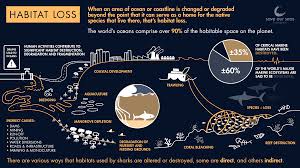
Introduction:
Habitat destruction, fueled by human activities, poses one of the most significant threats to global biodiversity and ecosystem stability. As natural habitats are transformed or degraded at alarming rates, countless species face extinction, and delicate ecological balances are disrupted. This article explores the causes and consequences of habitat destruction, along with potential solutions to mitigate its devastating effects.
Causes of Habitat Destruction:
Deforestation:
Logging for timber, agriculture, and urbanization are major contributors to deforestation.
Clear-cutting forests not only removes vital habitat for countless species but also reduces carbon sequestration, exacerbating climate change.
Urbanization and Infrastructure Development:
Rapid urban expansion consumes vast swaths of natural habitats, displacing wildlife and fragmenting ecosystems.
Construction of roads, highways, dams, and other infrastructure further disrupts habitats and impedes wildlife movement.
Agricultural Expansion:
Clearing land for agriculture, including large-scale monoculture farming, leads to the destruction of diverse ecosystems.
Practices like slash-and-burn agriculture result in the loss of forests and contribute to soil degradation and erosion.
Mining and Extractive Industries:
Mining activities, including surface mining and oil extraction, often result in the destruction of entire ecosystems and contamination of water sources.
Habitat destruction from mining operations extends beyond the extraction sites, impacting surrounding areas and biodiversity.
Climate Change:
Rising temperatures, altered precipitation patterns, and extreme weather events associated with climate change exacerbate habitat destruction.
Sea-level rise threatens coastal habitats, while changes in temperature and rainfall disrupt terrestrial ecosystems.
Consequences of Habitat Destruction:
Loss of Biodiversity:
Habitat destruction is a leading cause of species extinction, as organisms lose their homes and cannot adapt to rapidly changing environments.
Destruction of specialized habitats, such as coral reefs and wetlands, results in the loss of unique biodiversity hotspots.
Disruption of Ecosystem Services:
Healthy ecosystems provide essential services such as pollination, water purification, and carbon sequestration.
Habitat destruction diminishes these services, leading to negative impacts on human well-being and livelihoods.
Imbalance in Ecological Relationships:
Habitats are intricately interconnected, and the loss of one species or habitat can trigger cascading effects throughout entire ecosystems.
Disruptions to food webs, competition dynamics, and predator-prey relationships can lead to ecosystem instability and collapse.
Increased Vulnerability to Natural Disasters:
Intact habitats provide natural buffers against natural disasters such as floods, landslides, and hurricanes.
Habitat destruction reduces these protective functions, leaving communities more vulnerable to the impacts of extreme events.
Solutions to Mitigate Habitat Destruction:
Protected Areas and Conservation Efforts:
Establishing and effectively managing protected areas, such as national parks and nature reserves, can safeguard critical habitats and biodiversity.
Conservation initiatives aimed at restoring degraded habitats and promoting sustainable land management practices are essential.
Sustainable Development Practices:
Encouraging sustainable agriculture, forestry, and urban planning practices can minimize the negative impacts of human activities on habitats and ecosystems.
Adopting eco-friendly technologies and promoting responsible consumption can reduce the pressure on natural resources.
Policy Interventions and Legal Protections:
Enforcing laws and regulations that prohibit habitat destruction and promote habitat conservation is crucial.
Implementing economic incentives, such as payments for ecosystem services, can encourage landowners and businesses to prioritize conservation efforts.
Public Awareness and Education:
Increasing public awareness about the importance of habitats and biodiversity can foster support for conservation initiatives.
Education programs aimed at fostering environmental stewardship and promoting sustainable lifestyles can empower individuals to take action.
Conclusion:
Habitat destruction poses a grave threat to biodiversity, ecosystems, and human well-being. Addressing this challenge requires concerted efforts at local, national, and global levels, encompassing policy interventions, conservation initiatives, and public engagement. By taking decisive action to protect and restore habitats, we can safeguard the rich tapestry of life on Earth for future generations.